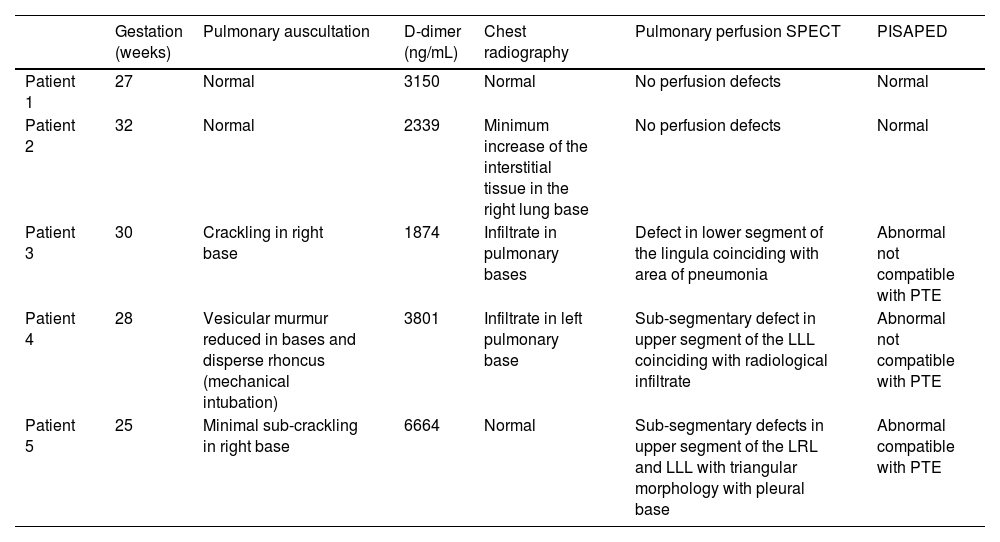To analyze a sample of pregnant patients who underwent pulmonary perfusion scintigraphy to rule out suspicion of pulmonary embolism (PE) during the acute COVID-19 infection hospitalization period in our hospital.
Material and methodsSPECT scintigraphy with a reduced dose (111MBq) of 99mTc-macroaggregated albumin was performed in all the patients (n=5). The images obtained were interpreted by comparing the findings with the radiological images according to the PISAPED criteria.
ResultsOnly one of the 5 patients was diagnosed with PE. Two patients showed pathological scintigraphy findings attributable to radiological alterations due to COVID-19 pneumonia, and the other two had normal pulmonary perfusion.
ConclusionGiven the non-specific features of the clinical manifestations and d-dimer values in COVID-19, as well as their similarity to those of PE, pulmonary perfusion scintigraphy plays a crucial role in the screening of PE in these patients due to its high sensitivity and lower irradiation compared to CT. Despite the limited number of patients, the results obtained have special relevance due to the absence of scientific publications in this group of patients within the exceptional context of the COVID-19 pandemic.
Analizar la muestra de pacientes embarazadas a las que se le realizó una gammagrafía de perfusión pulmonar para descartar la sospecha de tromboembolismo pulmonar (TEP) durante el ingreso en nuestro centro por infección aguda por COVID-19.
Material y métodosA todas las pacientes (n=5) se les realizó una gammagrafía SPECT con dosis reducida (111MBq) de 99mTc-macroagregados de albúmina. Las imágenes obtenidas se interpretaron comparando los hallazgos con la imagen radiológica según criterios PISAPED.
ResultadosDe las 5 pacientes, tan sólo en una se diagnosticó TEP. En dos pacientes los hallazgos patológicos de la gammagrafía fueron atribuibles a alteraciones radiológicas por neumonía COVID-19, y otras dos mostraron una perfusión pulmonar normal.
ConclusiónDado lo inespecífico de las manifestaciones clínicas y valores del dímero-D dentro de la COVID-19, así como su similitud con los de TEP, la gammagrafía de perfusión pulmonar, por su alta sensibilidad y menor irradiación que la TC, tiene un papel crucial en el despistaje de TEP en estas pacientes. Los resultados obtenidos son de especial relevancia, a pesar del número limitado de pacientes, dada la ausencia de publicaciones científicas en este grupo de pacientes dentro de la situación excepcional por la pandemia COVID-19.
Artículo

Revista Española de Medicina Nuclear e Imagen Molecular (English Edition)
Comprando el artículo el PDF del mismo podrá ser descargado
Precio 19,34 €
Comprar ahora









